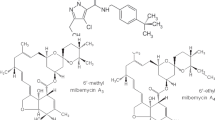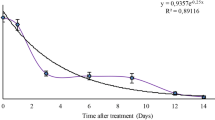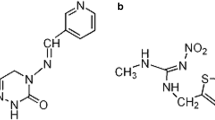Abstract
A risk assessment for imidacloprid applied on strawberries under different conditions was performed after residue determination using the quick, cheap, effective, rugged, and safe (QuEChERS) method. The application conditions were varied according to the applied dosage, addition of a plant oil or organosilicon surfactant, water volume, and sprayer type. The degradation dynamics of imidacloprid on strawberries followed first-order kinetics. At applied doses of 30–60 g a.i. ha−1, the half-lives of imidacloprid were 2.89–3.46, 1.98–3.65, and 2.57–2.77 days after application without a surfactant or with a plant oil or organosilicon surfactant, respectively. For water volumes of 112.5, 225, 450, 675, and 900 L ha−1, the half-lives of imidacloprid applied in the presence of the plant oil surfactant were 3.30, 7.70, 5.33, 7.70, and 6.30 days, respectively. The half-lives after application with a knapsack mist duster, electric sprayer, and manual sprayer were 2.16, 5.77, and 7.70 days, respectively. The health risk assessment revealed risk quotients less than 1 in all cases, indicating that the application of imidacloprid poses a low health risk to humans after a pre-harvest interval of 10 days under our application conditions. The risk assessment results can provide reference data for setting a reasonable maximum residue limit for imidacloprid on strawberries in China.

Similar content being viewed by others
Abbreviations
- ADI:
-
Acceptable daily intake
- BW:
-
Body weight
- CRL:
-
Calculated residue level
- FI:
-
Daily fruit intake
- GAP:
-
Good agricultural practices
- LOD:
-
Limit of detection
- LOQ:
-
Limit of quantitation
- MRL:
-
Maximum residue limit
- NEDI:
-
National estimated daily intake
- QuEChERS:
-
Quick, cheap, effective, rugged, and safe
- RQ:
-
Risk quotient
- RSD:
-
Relative standard deviation
- WP:
-
Wettable powder
- UVD:
-
Ultraviolet/visible (UV/Vis) detector
References
Chun OK, Kang HG (2003) Estimation of risks of pesticide exposure by food intake, to Koreans. Food and Chem Toxicol 41:1063–1076
China Customs. (2016). Statistics of trade. http://www.haiguan.info/OnLineSearch/TradeStat/StatComSub.aspx?TID=1. Accessed 2016-06-30
El-Hamady SE, Kubiak R, Derbalah AS (2008) Fate of imidacloprid in soil and plant after application to cotton seeds. Chemosphere 71:2173–2179
European Union. Pesticide residues in food (2016) http://ec.europa.eu/food/plant/pesticides/eupesticides-database/public/?event=pesticide.residue.selection&language=EN. Accessed 2017-2-26
European Union Reference Laboratories. SANCO/12495/2011. Method validation and quality control procedures for pesticide residues analysis in food and feed (2011). http://ec.europa.eu/food/plant/protection/pesticides/docs/qualcontrol_en.pdf. Accessed April 2013
Food and Agriculture Organization of the United Nations. Pesticide residues in food 2016. (2016). http://www.fao.org/3/a-i5693e.pdf. Accessed 2016-06-26
Liu CY, Lu DH, Wang YC, Huang JX, Wan K, Wang FH (2014) Residue and risk assessment of pyridaben in cabbage. Food Chem 149:233–236
Gupta M, Sharma A, Shanker A (2008) Dissipation of imidacloprid in Orthodox tea and its transfer from made tea to infusion. Food Chem 106:158–164
Itoiz ES, Fantke P, Juraske R, Kounina A, Vallejo AA (2012) Deposition and residues of azoxystrobin and imidacloprid on greenhouse lettuce with implications for human consumption. Chemosphere 89:1034–1041
Juraske R, Fantke P, Ramírez AC, González A (2012) Pesticide residue dynamics in passion fruits: comparing field trial and modelling results. Chemosphere 89:850–855
Malhat F, Badawy HM, Barakat DA, Saber AN (2014) Residues, dissipation and safety evaluation of chromafenozide on strawberry under open field conditions. Food Chem 152:18–22
Miranda-Fuentes A, Rodríguez-Lizana A, Cuenca A, Gonzalez-Sanchez EJ, Blanco-Rold GL, Gil-Ribes JA (2017) Improving plant protection product applications in traditional and intensive olive orchards through the development of new prototype air-assisted sprayers. Crop Prot 94:44–58
Ministry of Agriculture, Chinese National Health and Family Planning Commission. GB 2763-2016. National food safety standard maximum residue for pesticides in food. (2016). http://gain.fas.usda.gov/Recent%20GAIN%20Publications/Maximum%20Residue%20Limits%20for%20Pesticides%20in%20Food_Beijing_China%20-%20Peoples%20Republic%20of_4-30-2014.pdf (translated from Chinese). Accessed 2017–01-12
Sánchez-Hermosilla J, Rincón VJ, Páez F, Fernández M (2012) Comparative spray deposits by manually pulled trolley sprayer and a spray gun. Crop Prot 31:119–124
Stephenson GR, Ferris IG, Holland PT, Nordberg M (2006) Glossary of terms relating to pesticides (IUPAC recommendations 2006). Pure and Appl Chem 78:2075–2154
The Japan Food Chemical Research Foundation. Positive List System for Agricultural Chemical Residues in Foods. http://www.m5.ws001.squarestart.ne.jp/foundation/search.html. Access 2016.6.04
Thompson JR, Wetzel S, Klerks MM, Vaskova D, Schoen CD, Spak J, Jelkmann W (2003) Multiplex RT-PCR detection of four aphid-borne strawberry viruses in Fragaria spp. in Combination with a plant mRNA specific internal control. J. Virol Methods 111:85–93
Utture SC, Banerjee K, Kolekar SS, Dasgupta S, Oulkar DP, Patil SH, Wagh SS, Adsule PG, Anuse MA (2012) Food safety evaluation of buprofezin, dimethoate and imidacloprid residues in pomegranate. Food Chem 131:787–795
Wang ZW, Cang T, Qi PP, Zhao XP, Xu H, Wang XQ, Zhang H, Wang XQ (2015) Dissipation of four fungicides on greenhouse strawberries and an assessment of their risks. Food Control 55:215–220
Zhao HD, Xie C, Liu FM, He XK, Zhang J, Song JL (2014) Effects of sprayers and nozzles on spray drift and terminal residues of imidacloprid on wheat. Crop Prot 60:78–82
Zhang F, Wang L, Zhou L, Wu D, Pan H, Pan C (2012) Residue dynamics of pyraclostrobin in peanut and field soil by QuEChERS and LCeMS/MS. Ecotoxicol Environ Saf 78:116–122
Funding
This work was supported by the Special Fund for Agro-scientific Research in the Public Interest (Grant No. 201303088).
Author information
Authors and Affiliations
Corresponding author
Additional information
Responsible editor: Philippe Garrigues
Rights and permissions
About this article
Cite this article
Cang, T., Sun, C., Zhao, H. et al. Residue behavior and risk assessment of imidacloprid applied on greenhouse-cultivated strawberries under different application conditions. Environ Sci Pollut Res 25, 5024–5032 (2018). https://doi.org/10.1007/s11356-017-0653-3
Received:
Accepted:
Published:
Issue Date:
DOI: https://doi.org/10.1007/s11356-017-0653-3




